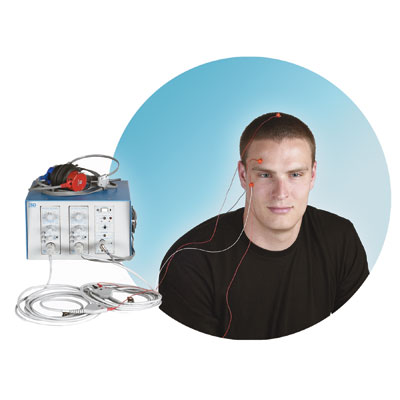Evoked potential tests are simple but powerful techniques that can provide huge insights into neuroscience and related fields. Here, we cover the basics of evoked potential tests, covering the neurophysiological basis of evoked potential and how this is used in research.
What is an evoked potential?
The human nervous system transmits signals using varying electric potentials. These signals are transmitted through the body via neurons (nerve cells), enabling communication between different parts of the body as well as higher cognitive processing in the brain.
Measuring the electrical potential at a given point in the nervous system, therefore, gives us a way to objectively measure neural activity.
An evoked potential is a type of electrical activity that is produced in part of the nervous system in response to external stimulation.1 Different types of stimuli produce different types of sensory potential, which can be classified according to their electrical polarity (positive or negative) and timing (by the order in which they occur, or in milliseconds).
For example, the P50 is a positive evoked potential that occurs in humans approximately 50 ms after the presentation of a stimulus such as an auditory click, visual stimulus, or physical touch.
Evoked potential vs. event-related potential (ERP)
It is helpful to note that some sources make a distinction between an evoked potential and an event-related potential (ERP). The American Psychological Association maintains that the two terms are distinct, with ERP instead referring to “higher level” processes, which typically have longer latency times.1,2 For example, the P300 is often considered an ERP rather than an evoked potential since it is considered to be a result of higher-level processing.3 However, this distinction is not well-defined and, while it is helpful to note that the term “evoked potential” is often used to refer specifically to “simple” responses with particularly short latencies, the two terms refer to essentially the same phenomena: an electrochemical neural response to a stimulus. As a result, the two terms are often used interchangeably.

Evoked Potentials in Neuroscience
The measurement and characterization of different types of evoked potential (and ERPs alike) are fundamental methods of neuroscience. Even seemingly simple studies of evoked potential timing can yield significant insight into neural functioning and neurological problems.
Take the P50 potential, for example, this is a (positive) evoked potential that occurs approximately 50 ms after a stimulus – such as an auditory click – is presented. In a paired click test, two auditory clicks are presented to a subject, with the second click occurring approximately 500 ms after the first. Typical subjects will exhibit a normal P50 response to the first click, but a suppressed P50 response in response to the second click.
This P50 suppression is considered an example of sensory gating: a neural process by which responses to redundant or irrelevant stimuli are suppressed to prevent overstimulation in the higher cortical centers of the brain.
Studies have found that subjects with schizophrenia fail to show a reduced P50 response to the second click in a paired click test.4,5 This makes abnormal P50 suppression a valuable biomarker in the diagnosis of schizophrenia.
Measuring Evoked Potential
Today, measurements of evoked potential are easily carried out by placing measurement electrodes on the skin, usually on the scalp or around the eye. Integrated systems such as SDI’s ERP lab provide an all-in-one measurement platform for researchers who have pre-identified landmark areas of the brain to study.6 With 6 electrodes and software presets for P50, P300, and mismatch negativity paradigms; the ERP-LAB provides an easy-to-use alternative to bulkier traditional ERP systems.
References and Further Reading
- evoked potential – APA Dictionary of Psychology. https://dictionary.apa.org/evoked-potential.
- event-related potential – APA Dictionary of Psychology. https://dictionary.apa.org/event-related-potentials.
- Zasler, N., MD, D. K. & Zafonte, R. D. Brain Injury Medicine: Principles and Practice. (Demos Medical Publishing, 2007).
- Haan, M. de. Infant EEG and Event-Related Potentials. (Psychology Press, 2013).
- Smith, A. K. et al. Cognitive Abilities and 50- and 100-msec Paired-Click Processes in Schizophrenia. AJP 167, 1264–1275 (2010).
- Evoked Response Potential | Evoked Potential | Evoked Response. San Diego Instruments https://sandiegoinstruments.com/product/erp-lab/.